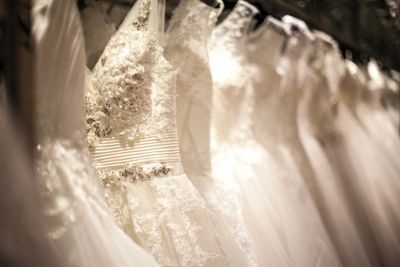 Your wedding dress is more than just the fabric and its color. As you shop, you might notice a lot of options from which you can select a frock that fits, flatters and matches your overarching vision for your event. Whether you opt for a traditional gown or a modern, fashion-forward dress, it’s a good idea to understand how small details play into the overall look of your garment.
Your wedding dress is more than just the fabric and its color. As you shop, you might notice a lot of options from which you can select a frock that fits, flatters and matches your overarching vision for your event. Whether you opt for a traditional gown or a modern, fashion-forward dress, it’s a good idea to understand how small details play into the overall look of your garment.
Silhouette and Structure Go Hand in Hand
One of the most important things you'll want to decide early on is what sort of shape you'd like your gown to have. Modern designers usually craft dresses in a wide range of silhouettes. These shapes not only serve as basic structures for these garments but also call attention to certain areas of your body while de-emphasizing other regions. The Knot published a basic guide to these shapes, listing some of the most common ones you’ll encounter during your search:
- A-line
- Ball gown
- Empire waist
- Mermaid
- Trumpet
- Sheath
- Dropped waist
The Knot suggests that the A-line shape is a universally great choice for most individuals, but many silhouettes are ideal for people taller or shorter than average as well as for those with slender, curvy or rectangular body shapes.
Choosing the Right Fabulous Fabrics
The materials in your dress contribute to both the look of dress as well as how comfortable you’ll feel wearing it. While dressmakers have employed a wide range of fabrics to produce their sartorial creations, a 2017 Brides article explains that several kinds are most commonly used in wedding frocks today:
- Tulle
- Chiffon
- Charmeuse
- Organza
- Lace
Writer Jolène M. Bouchon further details that satin is technically a finish, not a fabric in and of itself. You’ll recognize the glossy surface and soft yet sturdy texture that characterizes this weave, which can be fabricated from silk, polyester or various fiber blends. The sheerness of chiffon and the net-like quality of tulle give garments a weightless, airy look while the stiffness and lightweight feel of organza make it a top choice for warm weather nuptials. Charmeuse is shiny with an almost liquid-like visual effect, making it a great option for frocks that rely on draping effects in their aesthetics. Keep in mind that multiple types of fabric can be used in the same gown, depending on its design and detailing.
Embellishments: The Icing on the Cake
Beyond silhouette and fabric choices, designers also depend on intricate details to weave their magic when crafting each gown. From glittery extras to meticulously beaded patterns, each element is carefully chosen to execute the desired effect.
The folks at BrideBox give readers a rundown on some of the more common embellishments you’ll find as you shop for dresses. Lace has long been a matrimonial mainstay, and gowns in hues other than white have been around for centuries. Sequins are frequently regarded as a more contemporary addition to garments, but a 2012 Smithsonian Magazine piece elucidates that they’ve been around since the time of King Tut, serving as both visual extras and status symbols. Beads, ribbons, rhinestones and other pretty trimmings can end up on the front of a bodice, a hemline or a neckline and can be combined to weave an expertly designed back that demands to be shown off.
More Than the Sum of Its Parts
Many different elements come together when a wedding gown is being crafted: its silhouette and construction, the fabrics used in the garment and the little details that make it sparkle and shine. Although the traditional lacy white frock is an invention that’s less than a couple of centuries old, the fashions of each era and the creativity of individual dressmakers have also shaped the selection of apparel available on the market today.
Add Your Comment